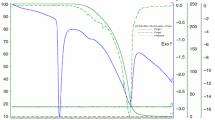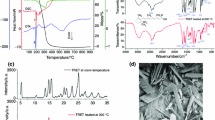Abstract
The aim of this work was to evaluate the quantitative characterization and pharmaceutical compatibility study of teneligliptin (TNG) with the commonly used excipients for solid dosage form employing thermogravimetric analysis, differential scanning calorimetry, liquid chromatography–mass spectrometer, powder X-ray diffraction, isothermal stress testing, optical microscopy and Fourier transform infrared spectroscopy as a supporting technique to contribute to the interpretation of results. The selected excipients were magnesium stearate (MS), sodium starch glycolate (SSG), croscarmellose sodium (CCS), pregelatinized starch (PS) and microcrystalline cellulose (MCC). On the basis of the DSC results, some interactions were found with TNG–CCS, TNG–MCC, TNG–MS, TNG–SSG and TNG–PS. However, during IST studies less than 3% change in TNG content was observed in all stressed binary mixtures except TNG–CCS, TNG–SSG (< 10%) which showed incompatibility with TNG. These results would be suitable for the formulation development of the solid dosage forms of TNG.








Similar content being viewed by others
References
Cho NH, Whiting D, Forouhi N, Guariguata L, Hambleton ILR, Majeed A, Mbanya JC,Montoya PA, Motala A, Narayan V, Ramachandran A, Rathmann W, Roglic G, J. Shaw, M. Silink, P. Zhang, IDF Diabetes Atlas. International Diabetes Federation, Karakas Print, Brussels, 7th ed. 2015; 1–144.
Kalra S, Das AK, Sahay R. Managing diabetes: the drivers of change. J Soc Health Diabetes. 2013;1:3–5.
Gulliford ML, Ariyanayagam BSM, Bickram L, Pleou D, Mahabir D. Counting the cost of diabetic hospital admissions from a multi-ethnic population in Trinidad. Diabet Med. 1995;12:1077–85.
Singh RB, Ghosh S, Niaz AM. Epidemiologic study of diet and coronary risk factors in relation to central obesity and insulin levels in rural and urban populations of north India. Int J Cardiol. 1995;47:245–55.
Wild S, Roglic G, Green A, Sicree R, King H. Global prevalence of diabetes. Diabetes Care. 2004;27:1047–53.
Yoshida T, Akahoshi F, Sakashita H, Kitajim H, Nakamura M, Sonda S, Takeuchi M, Tanaka Y, Ueda N, Sekiguchi S, Ishige T, Shima K, Nabeno M, Abe Y, Anabuki J, Soejima A, Yoshida K, Takashina Y, Ishii S, Kiuchi S, Fukuda S, Tsutsumiuchi R, Kosaka K, Murozono T, Nakamaru Y, Utsumi H, Masutomi N, Kishida H, Miyaguchi I, Hayashi Y. Discovery and preclinical profile of teneligliptin (3-[(2S,4S)- 4-[4-(3-methyl-1-phenyl-1H-pyrazol-5-yl)piperazin-1-yl]pyrrolidin-2-ylcarbonyl]thiazolidine): a highly potent, selective, long-lasting and orally active dipeptidyl peptidase IV inhibitor for the treatment of type 2 diabetes. Bioorganic Med Chem. 2012;20:5705–19.
Crowley PJ, Martini LG. Excipients in pharmaceutical products: encyclopedia of pharmaceutical technology. New York: Marcel Dekker Inc; 2002.
Bruni G, Amici L, Berbenni V, Marini A, Orlandi A. Drug-excipient compatibility studies. Search of interaction indicators. J Therm Anal Calorim. 2002;68:561–73.
Chaves LL, Rolim LA, Goncalves Maria LCM, Vieira Alexandre CC, Alves Lariza DS, Soares Monica FR, Soares-Sobrinho Jose L, Lima Maria CA, Rolim-Neto Pedro J. Study of stability and drug-excipient compatibility of diethylcarbamazine citrate. J Therm Anal Calorim. 2013;111:2179–86.
Singh AV. A DSC study of some biomaterials relevant to pharmaceutical industry. J Therm Anal Calorim. 2013;112:791–3.
Verma RK, Garg S. Selection of excipients for extended release formulations of glipizide through drug excipient compatibility testing. J Pharm Biomed. 2005;38:633–44.
Serajuddin AT, Thakur AB, Ghoshal RN, Fakes MG, Ranadive SA, Morris KR, Varia SA. Selection of solid dosage form composition through drug excipient compatibility testing. J Pharm Sci. 1999;88:696–704.
Jackson K. Drug excipient interactions and their effect on absorption. Pharm Sci Technol Today. 2000;3:336–45.
Monkhouse DC. Stability aspects of preformulation and formulation of solid pharmaceuticals. Drug Dev Ind Pharm. 1984;10:1373–412.
Kirtansinh G. Application of analytical techniques in preformulation study: a review. Int J Pharm Biol Sci Arch. 2011;2(5):1319–26.
Pinto MF, Moura EA, Desouza FS, Macedo RO. Thermal compatibility studies of nitroimidazoles and excipients. J Therm Anal Calorim. 2010;102:323–9.
Verma RK, Garg S. Compatibility studies between isosorbide mononitrate and selected excipients used in the development of extended release formulations. J Pharm Biomed Anal. 2004;38:633–44.
Singh AV, Nath LK. Evaluation of compatibility of tablet excipients and novel synthesized polymer with lamivudine. J Therm Anal Calorim. 2012;108:263–7.
ICH, Q2A (R1). Validation of analytical procedures: text and methodology. In: International conference on harmonisation; 2005.
Tita B, Fulias A, Bandur G, Marianc E, Tita D. Compatibility study between ketoprofen and pharmaceutical excipients used in solid dosage forms. J Pharm Biomed Anal. 2011;56:221–7.
Yoshida T, Sakashita H, Ueda N, Kirihara S, Uemori S, Tsutsumiuchi R, Akahoshi F. Salt of proline derivative, solvate thereof, and production method thereof, United States Patent, US 8,003,790 B2, Aug. 23, 2011.
Ali F, Kumar R, Sahu PL, Singh GN. Physicochemical characterization and compatibility study of roflumilast with various pharmaceutical dosage forms. J Therm Anal Calorim. 2017;130:1627–41.
Pavia DL, Lampmen GM, Kriz GS. Introduction to spectroscopy; Chapter 2. 3rd ed. Boston: Cengage Learning; 2008.
Silverstein RM, Webster FX, Kiemle DJ. Spectrometric identification of organic compounds; Chapter 2. 7th ed. Hoboken: Wiley; 2005.
Rus LM, Tomuta I, Iuga C, Maier C, Kacso I, Borodi G, Bratu I, Bojita M. Compatibility studies of indapamide/pharmaceutical excipients used in tablet preformulation. Farmacia. 2012;60:92–101.
Peres-Filho MJ, Gaeti MPN, Oliveira SR, Marreto RN, Lima EM. Thermoanalytical investigation of olanzapine compatibility with excipients used in solid oral dosage forms. J Therm Anal Calorim. 2011;104:255–60.
Roumeli E, Tsiapranta A, Pavlidou E, Vourlias G, Kachrimanis K, Bikiaris D, Chrissafis K. Compatibility study between trandolapril and natural excipients used in solid dosage forms. J Therm Anal Calorim. 2013;111:2109–15.
Daniel JSP, Veronez IP, Rodrigues LL, Trevisana MG, Garcia JS. Risperidone–solid-state characterization and pharmaceutical compatibility using thermal and non-thermal techniques. Thermochim Acta. 2013;568:148–55.
Acknowledgements
The author Faraat Ali is grateful to Indian Pharmacopoeia Commission (IPC), Ministry of Health & Family Welfare, Govt. of India, India, for providing necessary instrumental facilities. All the authors have no conflict of interest regarding this publication. This article does not contain any studies with human and animal subjects applied by any of the authors.
Author information
Authors and Affiliations
Corresponding author
Rights and permissions
About this article
Cite this article
Ali, F., Nandi, U., Trivedi, M. et al. Quantitative characterization and pharmaceutical compatibility between teneligliptin and widely used excipients by using thermal and liquid chromatography tandem mass spectrometry techniques. J Therm Anal Calorim 132, 385–396 (2018). https://doi.org/10.1007/s10973-018-6962-z
Received:
Accepted:
Published:
Issue Date:
DOI: https://doi.org/10.1007/s10973-018-6962-z




